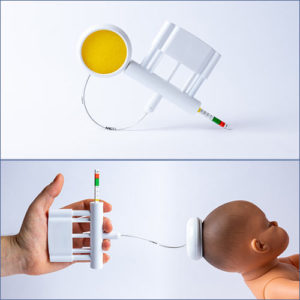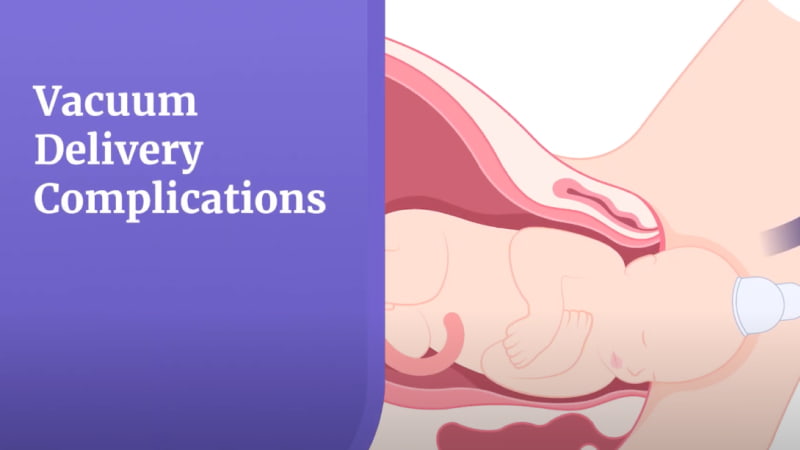What Is Vacuum Extraction?

Vacuum extractors are a tool doctors may use during a difficult or prolonged delivery to help guide the baby out. A soft suction cup is placed on the baby’s head and gently pulled as the mother pushes.
In 2025, vacuum extraction is used in 3% of vaginal deliveries in the United States, according to Cleveland Clinic.
While usually safe, vacuum extraction complications can occur if the tool is used improperly.
If a vacuum-assisted delivery is performed incorrectly, the baby may suffer serious injuries like brain bleeds, cerebral palsy, or other types of brain damage.
You may qualify for financial compensation if a vacuum-assisted delivery harmed your child. An experienced vacuum extraction injury lawyer can help your family seek justice and the money you deserve.
The Birth Injury Justice Center works with top birth injury lawyers who can help families in all 50 states. So far, our legal partners have recovered over $1 billion for families affected by preventable birth trauma, including vacuum extraction complications.
If you suspect your child’s condition could have been avoided, our team may be able to help you access financial support. Get a free case review to find out if you may qualify.
Reasons for Vacuum Delivery
Vacuum extraction is typically used during the second stage of labor, when the cervix is fully dilated and the baby has descended headfirst into the birth canal.
- Abnormal fetal heart rate suggests the baby is in distress
- Maternal exhaustion prevents continued effective pushing
- Medical conditions limit how long the mother can safely push
- Progress stalls despite active pushing and full dilation
In some cases, vacuum extraction may help avoid a cesarean delivery (C-section). However, if a vacuum delivery cannot be performed safely, a C-section is typically recommended.
What Causes Vacuum Extraction Complications?
Improper use of the tool is one of the leading causes of vacuum delivery complications. As a result, this procedure should only be performed when medically necessary.
“Some hospitals have strict vacuum delivery rules — how many pop-offs are allowed, what to do after each, and when to stop. But not all hospitals follow these protocols. In my work, I’ve seen how outdated or missing policies can lead to more serious complications of vacuum delivery.”
– Kristin Proctor, RN, On-Staff Registered Nurse
When things go wrong, babies may suffer vacuum birth complications. This includes nerve damage in the neck, spinal cord injury, or trauma to the scalp and skull if too much suction is used.
Watch our short video to learn more about what causes vacuum extraction complications.
Learn about the risks and complications of vacuum extraction during childbirth and what steps you can take if your baby was harmed. View Transcript.
Duration: 1 min 22 sec
Assistive devices like vacuum extractors can be necessary during a difficult delivery. However, even though most vacuum extractions are successful, this procedure can pose risks to both the mother and the child.
While vacuum extraction may be required in some vaginal deliveries, it should only be performed when there is a need to remove the baby from the birth canal quickly.
Serious complications can arise from vacuum deliveries, including brain damage, Erb’s palsy, skull fractures, and cephalohematomas. These complications can lead to developmental delays and permanent disability.
Sometimes, these complications are caused by doctors who misuse the vacuum device during delivery or fail to provide prompt and appropriate treatment after the procedure. These preventable medical mistakes are considered medical malpractice.
If your child suffered vacuum delivery complications due to medical negligence, you may be entitled to financial compensation. It’s important to explore your options and seek justice for any harm caused.
The Birth Injury Justice Center can help you connect with experienced birth injury lawyers and pursue financial assistance for medical negligence. Take action right now and protect your rights and your child’s future.
Some vacuum extraction complications cannot be avoided. However, they are often the result of improper use of the delivery tool, which can mean that medical negligence occurred.
If you think your baby’s vacuum extraction complications could have been prevented, you probably have questions. Our registered nurses are here to help you understand what happened. Connect with a labor and delivery nurse now — at no cost.
Risk Factors for Vacuum Delivery Complications
Certain conditions increase the risk of injury during a vacuum-assisted birth. Medical providers must carefully evaluate these risks before deciding on a vacuum-assisted vaginal delivery.
“Physicians must weigh the risks before using assisted delivery tools. If the baby is too large, vacuum extractors or forceps may increase the chance of injury.”
– Katie Lavender, RN
- Baby’s head is too high in the birth canal and hasn’t descended far enough
- Bleeding or bone problems make the baby more vulnerable to injury
- Early labor before 34 weeks, as the baby’s skull is softer and more fragile
- Head position is unclear, which makes safe vacuum use difficult
- Large baby size raises the chance of getting stuck during delivery
If any of these risks are present, vacuum delivery may not be safe — and using it anyway could lead to serious harm.
Watch for vacuum extraction complications warning signs after birth, especially if your baby is slow to meet milestones or shows signs of injury.
Effects of Vacuum Extraction Complications
Vacuum extraction injuries that aren’t treated promptly can lead to various medical issues. Some vacuum extraction complications are minor and resolve immediately, but others may be more severe and last longer.
Learn about potential short- and long-term vacuum extraction complications below.
Short-Term Effects of Vacuum Delivery Complications
Vacuum-assisted birth can cause noticeable changes to a newborn’s head. Many of these issues are temporary and part of the normal healing process, but some may require medical attention.
It’s common to see a bump on your baby’s head after vacuum extraction caused by the suction cup. This soft swelling, called a chignon, usually fades within a few days.
In most cases, vacuum baby head healing time is short. Bruising, mild swelling, or a cone-like shape should improve within 1 to 2 weeks.
If the vacuum birth head shape appears unusually swollen, firm, or persists beyond that, it could be a sign of a more serious injury like a cephalohematoma or brain bleed.
Doctors should assess any concerns right away to rule out underlying complications and provide treatment if needed.
Long-Term Effects of Vacuum-Assisted Delivery
Vacuum baby delivery side effects can sometimes result in lasting harm. These long-term effects may require years of therapy, support, and medical care.
One of the most serious complications is bleeding in the brain, also called an intraventricular hemorrhage (IVH).
IVH can happen when the vacuum cup pulls too hard on a baby’s head, rupturing blood vessels. Pressure from the bleeding can lead to permanent brain damage.
Brain damage may cause developmental delays, especially if the injury affects motor or speech centers. In some cases, this damage may lead to lifelong conditions.
Other long-term vacuum extraction complications include:
- Cerebral palsy, often caused by brain injury during birth
- Erb’s palsy and other brachial plexus injuries from pulling
- Hypoxic-ischemic encephalopathy (HIE), caused by lack of oxygen
- Kernicterus, a type of brain damage from untreated jaundice
- Shoulder dystocia, which may cause nerve damage or paralysis
Some of these issues may not appear right away. It can take months or even years to notice speech problems, learning disabilities, or poor coordination.
If you notice warning signs or delays, your child may need a full medical evaluation. You may also qualify for financial help through a birth injury lawsuit.
Take our free milestones quiz now to see if your child is on track.
IS YOUR CHILD MISSING DEVELOPMENTAL MILESTONES?
Take Our Milestones Quiz
Taking note of your child’s physical, social, and emotional skills can help you determine if they potentially suffered from an injury at birth. An early diagnosis can help your child get the treatment they need as soon as possible.
Q1: How old is your child?
0-2 MONTHS DEVELOPMENTAL MILESTONES QUIZ
- Q2: Can your child hold their head steadily on their own?
- Q3: Can your child push themselves up when they are lying on their stomach?
- Q4: Has your child started to make smoother movements with their arms and legs?
- Q5: Does your child smile at other people?
- Q6: Can your child bring their hands to their mouth?
- Q7: Does your child turn their head when they hear a noise?
- Q8: Does your child coo or make gurgling noises?
- Q9: Does your child follow things with their eyes?
- Q10: Does your child try to look at their parents or caregivers?
- Q11: Does your child show boredom, cry, or fuss when engaged in an activity that hasn’t changed in a while?


3-4 MONTHS DEVELOPMENTAL MILESTONES QUIZ
- Q2: Can your child hold their head steadily on their own?
- Q3: Does your child push down on their legs when their feet are on a flat surface?
- Q4: Has your child started to roll over from their stomach to their back?
- Q5: Can your child hold and shake a toy such as a rattle?
- Q6: Does your child bring their hands to their mouth?
- Q7: Does your child play with people and start to cry when the playing stops?
- Q8: Does your child smile spontaneously, especially at people?
- Q9: Does your child copy some movements and facial expressions of other people?
- Q10: Does your child babble with expressions and copy sounds they hear?
- Q11: Does your child cry in different ways to show hunger, pain, or tiredness?
- Q12: Does your child respond to affection like hugging or kissing?
- Q13: Does your child follow moving things with their eyes from side to side?
- Q14: Does your child recognize familiar people at a distance?


5-6 MONTHS DEVELOPMENTAL MILESTONES QUIZ
- Q2: Can your child roll over on both sides (front to back/back to front)?
- Q3: Has your child begun to sit without support?
- Q4: Does your child rock back and forth?
- Q5: Can your child support their weight on their legs (and perhaps bounce) when standing?
- Q6: Has your child begun to pass things from one hand to the other?
- Q7: Does your child bring objects such as toys to their mouth?
- Q8: Does your child know if someone is not familiar to them and is a stranger?
- Q9: Does your child respond to other people’s emotions, such as a smile or a frown?
- Q10: Does your child enjoy looking at themselves in the mirror?
- Q11: Does your child look at things around them?
- Q12: Does your child respond to sounds they hear by making sounds themselves?
- Q13: Does your child make sounds to show joy or displeasure?
- Q14: Does your child respond to their own name?
- Q15: Has your child started to string vowels together, such as "ah," "eh," or "oh," or started to say consonant sounds such as "m" or "b"?
- Q16: Has your child begun to laugh?


7-9 MONTHS DEVELOPMENTAL MILESTONES QUIZ
- Q2: Can your child crawl?
- Q3: Can your child stand while holding on to something to support them?
- Q4: Can your child sit without support?
- Q5: Can your child pull themselves up to stand?
- Q6: Does your child play peekaboo?
- Q7: Can your child move things from one hand to the other?
- Q8: Can your child pick small things up, such as a piece of cereal, with their thumb and index finger?
- Q9: Does your child look for things that they see you hide?
- Q10: Does your child watch the path of something as it falls?
- Q11: Does your child show fear when around strangers?
- Q12: Does your child become clingy with adults who are familiar to them?
- Q13: Does your child have favorite toys?
- Q14: Does your child use their fingers to point?
- Q15: Does your child understand “no”?
- Q16: Does your child make a lot of repetitive sounds, such as “mamama” or “bababa”?
- Q17: Does your child copy the sounds and gestures of other people?


10-12 MONTHS DEVELOPMENTAL MILESTONES QUIZ
- Q2: Can your child stand alone with no support?
- Q3: Does your child walk while holding on to furniture?
- Q4: Can your child take a few steps without holding on to anything?
- Q5: Can your child get into a sitting position without any help?
- Q6: Does your child bang two things together when playing?
- Q7: Does your child poke with their index finger?
- Q8: Has your child started to use things like hairbrushes or drinking cups correctly?
- Q9: Does your child find hidden objects easily?
- Q10: Does your child play peekaboo or pat-a-cake?
- Q11: Does your child become shy or nervous around strangers?
- Q12: Does your child repeat actions or sounds to get attention?
- Q13: Does your child put out an arm or leg to help when getting dressed?
- Q14: Does your child cry when a parent leaves the room?
- Q15: Does your child show that they have favorite things or people?
- Q16: Does your child show fear?
- Q17: Does your child say things such as “mama,” “dada,” or “uh-oh”?
- Q18: Does your child try to say the words you say?
- Q19: Has your child started to use gestures like waving or shaking their head “no”?


13-18 MONTHS DEVELOPMENTAL MILESTONES QUIZ
- Q2: Can your child walk by themselves?
- Q3: Does your child walk up stairs and run?
- Q4: Does your child pull toys while walking?
- Q5: Can your child drink from a cup on their own?
- Q6: Can your child eat with a spoon on their own?
- Q7: Can your child help undress themselves?
- Q8: Does your child have occasional temper tantrums?
- Q9: Does your child show affection to familiar people?
- Q10: Does your child become clingy in new situations?
- Q11: Does your child explore their environment alone with parents close by?
- Q12: Can your child say several single words?
- Q13: Can your child say and shake their head “no”?
- Q14: Does your child point to show things to other people?
- Q15: Does your child scribble?
- Q16: Does your child know what ordinary products such as phones, spoons, and brushes are used for?
- Q17: Can your child follow one-step commands such as “sit down” or “stand up”?
- Q18: Does your child play with a doll or stuffed animal by pretending to feed it?


19-23 MONTHS DEVELOPMENTAL MILESTONES QUIZ
- Q2: Has your child begun to run?
- Q3: Has your child kicked a ball?
- Q4: Can your child climb down and onto furniture on their own?
- Q5: Can your child walk up and down stairs while holding on?
- Q6: Can your child stand on their tiptoes?
- Q7: Has your child thrown a ball overhand?
- Q8: Does your child copy others, especially people older than them?
- Q9: Does your child get excited around other children?
- Q10: Has your child shown more independence as they've aged?
- Q11: Does your child do what they were told not to do and become defiant?
- Q12: Does your child point to things when they are named?
- Q13: Does your child know names of familiar people or body parts?
- Q14: Does your child say 2 to 4-word sentences?
- Q15: Does your child repeat words they hear?
- Q16: Does your child complete sentences and rhymes in familiar books?
- Q17: Does your child name items in books, such as dogs, cats, and birds?
- Q18: Does your child play simple pretend games?
- Q19: Has your child started to use one hand more than the other?
- Q20: Has your child begun to sort shapes and colors?
- Q21: Does your child follow 2-step instructions, such as “pick up your hat and put it on your head?”


24+ MONTHS DEVELOPMENTAL MILESTONES QUIZ
- Q2: Can your child run easily?
- Q3: Can your child climb?
- Q4: Can your child walk up and down stairs with one foot on each step?
- Q5: Can your child dress and undress themselves?
- Q6: Does your child show affection for friends without being told?
- Q7: Does your child take turns when playing games?
- Q8: Does your child show concern when others are crying?
- Q9: Does your child understand the idea of “mine" and "theirs"?
- Q10: Does your child show many different emotions?
- Q11: Does your child copy adults and friends?
- Q12: Does your child separate easily from their parents?
- Q13: Does your child get upset when there is a major change in their routine?
- Q14: Does your child say words such as “I,” “me,” “we,” “you,” and some plural nouns?
- Q15: Can your child say their first name, age, and gender?
- Q16: Can your child carry on a conversation with 2 to 3 sentences?
- Q17: Can your child work toys with buttons and other moving parts?
- Q18: Does your child play pretend with dolls, animals, or people?
- Q19: Can your child finish 3 or 4 piece puzzles?
- Q20: Can your child copy a circle when drawing?
- Q21: Can your child turn pages of a book one page at a time?
- Q22: Can your child turn door handles?


Treatment for Vacuum Extraction Complications
Prompt medical care can help reduce the risk of lasting harm after a vacuum delivery. Treatment may vary depending on the type and severity of the complication.
Here are 5 ways vacuum extraction complications may be treated:
- Monitoring in the NICU: Babies with suspected head injuries may be admitted to a neonatal intensive care unit for close observation.
- Imaging scans: If brain bleeding or skull fractures are suspected, doctors may order ultrasounds, CT scans, or MRIs to assess the extent of injury.
- Phototherapy: If vacuum-related bruising leads to jaundice, light therapy may be used to break down excess bilirubin in the blood.
- Medication: Seizures or swelling caused by brain injury may be treated with anti-seizure drugs or medications to reduce inflammation.
- Surgery: In rare cases, surgery may be needed to relieve pressure from a brain bleed or repair a skull fracture.
Physical, occupational, and speech therapies may begin in infancy to support long-term development. Early treatment can improve outcomes and may prevent permanent damage from vacuum extraction complications.
Vacuum Delivery Complications and Medical Malpractice
Doctors are trained to recognize when and how to use tools like vacuum extractors during delivery. If they misuse these tools or fail to treat complications quickly, it may be considered medical malpractice — and you may have the right to file a vacuum extraction lawsuit.
Examples of vacuum extraction malpractice include:
- Delaying treatment for complications like skull fractures or nerve damage
- Failing to recognize signs of distress during labor
- Using the vacuum device too many times or with too much force
Without immediate care, these complications can lead to long-term disabilities. If your child suffered serious harm after a vacuum-assisted delivery, our trusted vacuum extraction injury lawyers may be able to help.
Our legal partners have recovered over $1 billion for families affected by preventable birth injuries — and they’re ready to fight for yours.
Legal Help for Vacuum Extraction Complications
Vacuum extraction complications are preventable when medical professionals follow care guidelines correctly and provide prompt treatment to mothers and their babies. If your child was harmed, you may be able to file a vacuum extraction complications claim.
We’ve partnered with experienced birth injury lawyers who can help families in all 50 states. If you qualify, our legal partners will guide you through the process, uphold your rights, and fight for maximum compensation.
The attorneys in our network have secured more than $1 billion for families affected by preventable birth injuries, and they may be able to help your family, too.
Contact us now at (800) 914-1562 or fill out our case review form to see if we can help you provide a more secure future for your child.
Vacuum Extraction Complication FAQs
What is vacuum extraction?
Vacuum extraction (also called ventouse) is an assisted delivery method used during the second stage of labor to help guide a baby through the birth canal. This operative vaginal delivery works alongside the mother’s pushing rather than pulling the baby out directly.
Is vacuum delivery safe for babies?
Vacuum delivery is generally considered safe when used correctly, but it does carry risks, especially if the procedure is prolonged, misused, or done when a C-section would have been safer. The most serious risks include brain injury, nerve damage, and long-term developmental delays.
What are the potential complications of vacuum extraction?
Examples of vacuum extraction complications include scalp injuries such as bruising or swelling, as well as skull fractures.
In some cases, a condition called intracranial hemorrhage, which is bleeding inside the skull, can occur. This condition is considered severe.
If you suspect vacuum extraction complications may have harmed your child, you may be able to access money for their care. Get a free case review right now to find out if you may qualify.
What is the most serious complication of vacuum extraction?
The most serious vacuum extraction complications include skull fractures and intracranial hemorrhage, which can lead to brain damage, according to Cleveland Clinic. Additionally, subgaleal hemorrhage (bleeding between the scalp and skull) can lead to death if left untreated.
Can vacuum delivery cause brain damage?
Yes, vacuum extraction complications can cause brain damage. If the vacuum suction device isn’t placed on the baby’s head correctly or too much pressure is applied, it can seriously damage a newborn baby’s brain.
Brain damage can also occur from a lack of oxygen due to a vacuum-related injury. If you’re concerned vacuum extraction complications may have harmed your child, our nurses are here to help.
Call us at (800) 914-1562 or Click to Live Chat right now to connect with a member of our team.
Are there any side effects of vacuum delivery?
Yes, vacuum delivery can cause side effects for the baby. Most are mild, such as temporary scalp swelling, bruising, or minor cuts from the suction cup. These usually heal on their own without long-term problems.
However, more serious complications may occur if too much pressure is used or the procedure is mishandled.
Possible side effects of vacuum delivery include:
- Brain bleeds (intracranial hemorrhage)
- Developmental delays
- Hypoxic-ischemic encephalopathy (HIE)
- Nerve damage, like brachial plexus injuries
- Skull fractures
If you notice unusual symptoms in your baby after a vacuum pump delivery, talk to a doctor right away. Early care can make a big difference.
How long does it take to heal from a vacuum delivery?
Most mothers recover from a vacuum-assisted delivery within 6 to 8 weeks. Mild bruising, swelling, or soreness is common, but healing may take longer if there were tears or an episiotomy.
Babies often have temporary scalp swelling or bruising that fades within a few days. More serious injuries, like skull fractures or brain bleeds, may require longer recovery and specialized care.
How long does it take for a baby's head to round after vacuum extraction?
The soft cup used in vacuum extraction can cause a baby’s head to swell into a cone shape. However, the baby’s head should start to round 2-3 days after birth.
Can vacuum-assisted delivery cause autism?
There’s no proven direct link between vacuum birth and autism. Most studies, including those published in peer-reviewed medical journals, have found no strong evidence that vacuum-assisted delivery causes autism spectrum disorder (ASD).
However, vacuum extraction complications, such as oxygen loss, brain bleeding, or trauma, may increase the risk of neurological problems. These complications are not exclusive to autism and can also lead to developmental delays or cerebral palsy.
Which is better: vacuum or forceps?
Both vacuum extraction and forceps delivery have advantages and disadvantages. Some studies have shown that rates of shoulder dystocia and newborn cephalohematoma are lower in babies delivered by vacuum extraction versus forceps.
On the other hand, these studies also found that the risk of maternal complications, especially vaginal tears, is higher with the use of forceps.
Doctors are responsible for choosing the assistive device that is best for the mother and baby.







